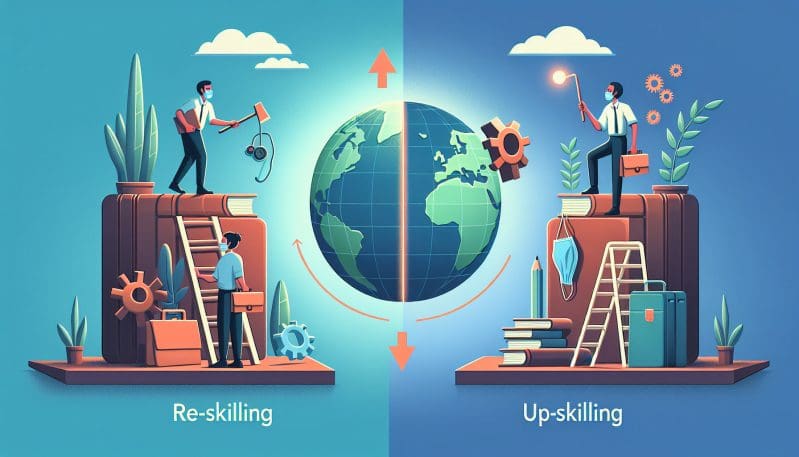Re-skilling vs. Up-skilling: Navigating the Skills Revolution in a Post-Pandemic World
- Home
- Re-skilling vs. Up-skilling: Navigating the Skills Revolution in a Post-Pandemic World

- Editors Desk
- January 11, 2024
- 0 Comments
As the embers of the pandemic begin to cool, the landscape of work is undeniably altered. A ‘Skills Revolution’ is upon us, where the demand for new and evolved skill sets has soared to unprecedented heights. At the core of this revolution lie two key strategies for workforce development: re-skilling and up-skilling. While they may sound similar, they serve distinct purposes in the realm of talent management and organizational growth.
Re-skilling is the process of learning new skills so you can do a different job, or training people to do a different job. As certain jobs become obsolete and new ones emerge, re-skilling becomes critical. It’s about future-proofing the workforce by equipping them with the knowledge and tools needed to pivot into new roles that are in demand. For instance, a retail store manager might learn data analytics to transition into a supply chain analysis role.
On the other hand, up-skilling refers to the practice of teaching current employees new skills that will enhance their performance in their existing roles. This might include a software developer learning a new programming language or a sales professional mastering the latest CRM software. Up-skilling is an investment in workforce potential, aimed at increasing productivity and engagement within current job frameworks.
Both strategies are pivotal in maintaining a competitive edge in today’s fast-evolving job market. Employers play a crucial role in facilitating these learning opportunities. It’s in their best interest to develop a skilled workforce ready to meet the challenges of the new economy. This means not only offering training programs but creating a culture that values continuous learning and professional growth.
Governments, too, have a stake in this Skills Revolution. They are tasked with creating policies that encourage workforce development and provide support for those needing to transition between industries or job functions. This may come in the form of tax incentives for companies that invest in employee training, funding for educational institutions that offer applicable courses, or unemployment benefits that include access to re-skilling programs.
The impact on workers who are not provided with the means to adapt could be significant. Without the opportunity to re-skill or up-skill, these workers might find themselves stuck in roles with limited future prospects or facing unemployment. This not only affects individual livelihoods but can also have broader economic consequences as the skills gap widens.
To ensure that no worker gets left behind, a framework for continuous learning must be implemented. This could involve:
1. Personalized learning paths that consider individual career aspirations and learning styles.
2. Collaboration between businesses, governments, and educational institutions to create relevant and accessible training programs.
3. A shift in organizational culture to one that rewards initiative, curiosity, and a willingness to learn.
4. Financial and structural support for workers to take on internships, apprenticeships, or part-time roles that facilitate hands-on learning.
In conclusion, as we navigate this Skills Revolution, the distinction between re-skilling and up-skilling becomes crucial. By understanding their roles, promoting corporate and governmental responsibility, and advocating for inclusive learning frameworks, organizations can not only survive but thrive in the post-pandemic world. The future of work demands adaptability, and with a commitment to continuous development, we can ensure that every worker has the chance to grow and succeed in the evolving workplace landscape.

Leave A Comment